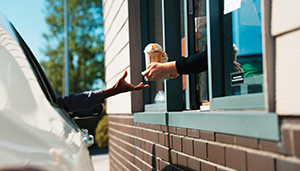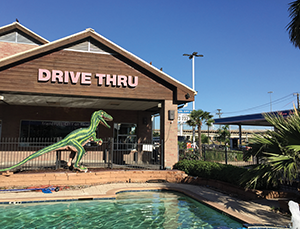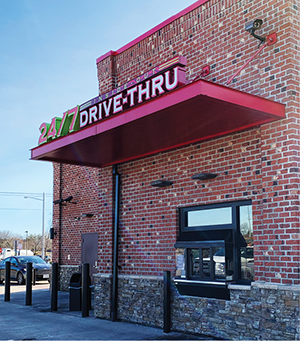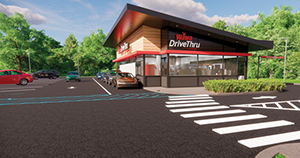 EG Group leaned on drive-thrus in its European stores during the pandemic lockdowns to serve foodservice customers.
EG Group leaned on drive-thrus in its European stores during the pandemic lockdowns to serve foodservice customers.
Each of the three stores opened by Oklahoma’s Jiffy Trip chain in the past three years has a drive-thru window, and according to Alex Williams, COO, that’s likely to be the model going forward. “We’re committed to them,” he said, pointing to drive-thrus’ popularity in the QSR channel, as well as changing consumer demands. “Whether it’s families with children or people in a hurry, fewer customers want to go in store. A convenience store with a drive-thru has an advantage over those without one. It’s a differentiator.”
Jiffy Trip is far from the only c-store company enamored with drive-thrus these days. “The pandemic has been a game changer,” explained Howland Blackiston, principal at King-Casey, which advises restaurants and c-stores on store design. Noting that pandemic lockdowns often meant that “drive-thru was the only option” for consumers to purchase foodservice items, Blackiston said consumers increasingly expect that convenience.
Drive-thru is all about speed."
Indeed, Ilyas Munshi, group commercial director at EG Group, a U.K.-based c-store powerhouse that operates numerous drive-thrus in Europe, remarked that the company’s investment in the concept “has been fundamental to the success of our foodservice brand partners,” including Starbucks, KFC and Burger King. As pandemic lockdowns in Great Britain eased, “the importance of drive-thru engagement became even more prevalent as customers weren’t comfortable accessing traditional in-store seating facilities,” Munshi said. Operators of drive-thru c-stores in the U.S. report similar results. Victor Arechaveleta, vice president, business development, at Farm Stores Franchising LLC—whose 48 franchised stores are exclusively drive-thru—said that at the peak of the pandemic, individual locations saw sales double.
 Jiffy Trip's three newest stores in Oklahoma include drive-thrus.
Jiffy Trip's three newest stores in Oklahoma include drive-thrus.
To be sure, for QSR operators drive-thrus have emerged as a lifeline, accounting for 50% and more of store sales. But for c-stores, drive-thrus are a more complicated proposition. Joseph Bona, president, Bona Design Lab, a retail design consulting firm, said c-stores have lagged behind QSRs in embracing drive-thrus due to the nature and scope of products sold. “QSR outlets sell maybe a couple dozen items,” he explained. “But for c-stores, with so many items stocked, the question becomes, what do you run through your drive-thru?” Blackiston recommends that c-stores limit drive-thru orders to foodservice items. “Drive-thru is all about speed. Food is highly profitable. Why push other things?” he asked. Other considerations for c-store operators include site location in the midst of fuel pumps, parking and even a car wash, as well as legalities related to age-restricted products.
A drive-thru will draw customers to you."
NO LOOKING BACK
Several c-store operators with long established drive-thrus, though, report they’ve been successful. Jiffy Trip opened its first drive-thru in 2018, and in recent years the model has evolved. The company’s app, for example, has helped speed up transaction times with foodservice orders placed in advance. Today, five of its 26 stores offer the windows—with no limits on the products sold. “Sales at our drive-thrus are growing,” said Williams. “We’re seeing a lot of repeat business.” In fact, Jiffy Trip plans to include a drive-thru at its first Arkansas store, slated to open later this year or early 2023.
 Fuel City takes a whimsical approach to a drive-thru near Dallas, Texas, a location featured in the 2017 NACS Ideas 2 Go series.
Fuel City takes a whimsical approach to a drive-thru near Dallas, Texas, a location featured in the 2017 NACS Ideas 2 Go series.
Texas’s Fuel City, meanwhile, has operated a c-store with a drive-thru window for 22 years. According to Joseph Bickham, president, “whether it’s the weather or people just not wanting to get out of their cars, our drive-thru has been popular,” typically serving a few hundred vehicles a day on weekends, and accounting for about 5% of store sales. “Generally higher volume items pass through it,” Bickham continued, such as packaged beverages, beer and tobacco products. While “we don’t encourage” sales of all store items via the drive-thru, he said, Fuel City staff will fulfill customers’ orders at the window. Like Jiffy Trip, Fuel City plans to open a new location soon—its eighth—complete with a drive-thru.
On the East Coast, Wawa’s recent foray into drive-thrus has received quite a bit of attention. The Pennsylvania-based chain opened its first store with a drive-thru window in New Jersey in late 2020, followed by a drive-thru-only store in the Keystone State early last year. Bona sees opportunity for the latter model. “A drive-thru-only [model] may very well be the best approach for c-stores,” he remarked.
A convenience store with a drive-thru has an advantage over those without one."
COMPETITIVE EDGE
While drive-thrus for major c-store chains may be a new development, community-focused drive-thru markets have abounded for years. TJ’s Drive Thru in Bloomville, Ohio—literally a drive-thru as vehicles enter the door into the building—opened in 2008, and according to Jim Price, who owns the store with his wife, Toni, annual sales top $3 million, with half coming from the drive-thru. The only business in the town of 900 residents, TJ’s sells a full line of grocery items, as well as beer, wine and tobacco products via the drive-thru. Fastlane Drive-Thru in Chipley, Florida, a rural farming community, is set up similarly. “On a busy day, we may serve 250-300 vehicles,” said co-owner Melissa Lane, noting that items like beer, soft drinks, snacks, cigarettes and lottery tickets are popular. “We also do a good business for breakfast and lunch,” she said.
 Sheetz has several stores with drive-thru service, including this one in Manassas, Virginia.
Sheetz has several stores with drive-thru service, including this one in Manassas, Virginia.
Miami-based Farm Stores, meanwhile, are designed with an open doorway, and a store associate walks up to a vehicle, takes the order and delivers it. In-store traffic isn’t permitted. About 600 SKUs are typically offered, and according to Arechaveleta, baked items are the chain’s top-selling products. Individual stores serve between 200 and 400 vehicles a day.
The biggest benefits of c-store drive-thrus, according to retailers and channel experts, are the competitive and incremental business opportunities they provide. “A drive-thru will draw customers to you,” remarked Bona. “They’ll go next door if the option isn’t there.” Williams and Bickham agree. “We’re seeing a lot of business we may not have gotten,” noted the Jiffy Trip executive of his windows. “We’re blurring the lines a little bit with QSR.” Drive-thrus may even provide some cost savings, Bickham suggested. “With drive-thrus, customers bring their own air-conditioning and chairs. We’ve seen fewer requests for condiments, and there’s no clean up,” the retailer said.
 IMPULSE SALES IMPACT
IMPULSE SALES IMPACT
But drive-thrus may not be a good fit for every c-store, depending on customer, market and real estate conditions. St. Romain Oil Co.’s Y-Not Stop in Louisiana operated a drive-thru at one of its stores for two years, before shutting it down in the spring of 2020. According to Annie St. Romain Gauthier, co-owner, while at its peak drive-thru sales reached 14% of in-store sales, staffing was a big challenge, and “the dedication of space and redundant inventory wasn’t working for us. Operationally, it felt like an albatross around our necks.” Since shutting the drive-thru down, “we’ve continued to grow sales at that store at a faster pace than other stores,” remarked Gauthier, adding, “we’ve since built two new stores without drive-thrus with no regrets.”
Perhaps the biggest impediment to c-store expansion into drive-thrus is the loss of impulse sales that are a big driver for in-store sales growth. “C-stores remain a mostly impulse-driven industry, whereas QSRs are almost exclusively based on a defined purchase,” said Bona. For retailers, “providing choice is part of the impulse mission and a key reason why drive-thrus may be somewhat limiting for c-stores and therefore not a good fit.” At Farm Stores, which has no walk-in traffic, employees are trained to suggestively sell, such as a lighter to a customer purchasing a pack of cigarettes. “Our staff is more like waitstaff when it comes to upselling,” said Arechaveleta. Williams agreed that proper training of drive-thru personnel is imperative. “You can’t have a new employee working the drive-thru,” he said.
 Wawa made a big splash when it unveiled plans for its first drive-thru-only store in Morrisville, Pennsylvania. The focus of the new prototype store, which opened in January 2021, is on Wawa's most popular food and beverages items.
Wawa made a big splash when it unveiled plans for its first drive-thru-only store in Morrisville, Pennsylvania. The focus of the new prototype store, which opened in January 2021, is on Wawa's most popular food and beverages items.
C-store operators who have been successful with drive-thrus advise retailers considering the model to visit and study other drive-thrus, build from the ground up, rather than add on to existing stores, and to complete site research. Well-planned layout and design is also a must. “It’s imperative to acknowledge the importance of drive-thru design and the subsequent operations resourcing as poor drive-thru execution, especially speed of service, can impact brand perception and subsequently sales,” remarked EG’s Munshi.
Bickham expects that drive-thrus will become a bigger part of the c-store business in the years to come. “With air-conditioning, comfortable seating and Bluetooth, people love spending time in their cars,” he explained. It’s even possible that drive-thru c-store sales could grow to account for a substantial portion of store sales. “Post pandemic, there’s no doubt that drive-thrus offer a significant value to consumers,” said Arechaveleta, noting, “they already account for 100% of our sales.”